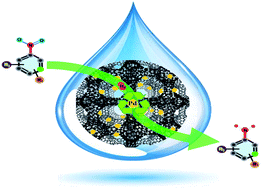Palladium nanoparticles embedded in mesoporous carbons as efficient, green and reusable catalysts for mild hydrogenations of nitroarenes†
Abstract
The reduction of nitroarenes is the most efficient route for the preparation of aromatic primary amines. These reductions are generally performed in the presence of heterogeneous transition metal catalysts, which are rather efficient but long and tedious to prepare. In addition, they contain very expensive metals that are in most cases difficult to reuse. Therefore, the development of efficient, easily accessible and reusable Pd catalysts obtained rapidly from safe and non-toxic starting materials was implemented in this report. Two bottom-up synthesis methods were used, the first consisted in the impregnation of a micro/mesoporous carbon support with a Pd salt solution, followed by thermal reduction (at 300, 450 or 600 °C) while the second involved a direct synthesis based on the co-assembly and pyrolysis (600 °C) of a mixture of a phenolic precursor, glyoxal, a surfactant and a Pd salt. The obtained composites possess Pd nanoparticles (NPs) of tunable sizes (ranging from 1–2 to 7.0 nm) and homogeneously distributed in the carbon framework (pores/walls). It turned out that they were successfully used for mild and environment-friendly hydrogenations of nitroarenes at room temperature under H2 (1 atm) in EtOH in the presence of only 5 mequiv. of supported Pd. The determinations of the optimal characteristics of the catalysts constituted a second objective of this study. It was found that the activity of the catalysts was strongly dependent on the Pd NPs sizes, i.e., catalysts bearing small Pd NPs (1.2 nm obtained at 300 °C and 3.4 nm obtained at 450 °C) exhibited an excellent activity, while those containing larger Pd NPs (6.4 nm and 7.0 nm obtained at 600 °C, either by indirect or direct methods) were not active. Moreover, the possibility to reuse the catalysts was shown to be dependent on the surface chemistry of the Pd NPs: the smallest Pd NPs are prone to oxidation by air and their surface was gradually covered by a PdO shell decreasing their activity during reuse. A good compromise between intrinsic catalytic activity (i.e. during first use) and possibility of reuse was found in the catalyst made by impregnation followed by reduction at 450 °C since the hydrogenation could be performed in only 2 h in EtOH or even in water. The catalyst was quantitatively recovered after reaction by filtration, used at least 7 times with no loss of efficiency. Advantageously, almost Pd-free primary aromatic amines were obtained since the Pd leaching was very low (<0.1% of the introduced amount). Compared to numerous reports from the literature, the catalysts described here were both easily accessible from eco-friendly precursors and very active for hydrogenations under mild and “green” reaction conditions.



 Please wait while we load your content...
Please wait while we load your content...